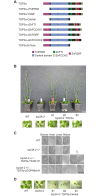The topoisomerase 3α zinc-finger domain T1 of Arabidopsis thaliana is required for targeting the enzyme activity to Holliday junction-like DNA repair intermediates
- PMID: 30222730
- PMCID: PMC6160208
- DOI: 10.1371/journal.pgen.1007674
The topoisomerase 3α zinc-finger domain T1 of Arabidopsis thaliana is required for targeting the enzyme activity to Holliday junction-like DNA repair intermediates
Abstract
Topoisomerase 3α, a class I topoisomerase, consists of a TOPRIM domain, an active centre and a variable number of zinc-finger domains (ZFDs) at the C-terminus, in multicellular organisms. Whereas the functions of the TOPRIM domain and the active centre are known, the specific role of the ZFDs is still obscure. In contrast to mammals where a knockout of TOP3α leads to lethality, we found that CRISPR/Cas induced mutants in Arabidopsis are viable but show growth retardation and meiotic defects, which can be reversed by the expression of the complete protein. However, complementation with AtTOP3α missing either the TOPRIM-domain or carrying a mutation of the catalytic tyrosine of the active centre leads to embryo lethality. Surprisingly, this phenotype can be overcome by the simultaneous removal of the ZFDs from the protein. In combination with a mutation of the nuclease AtMUS81, the TOP3α knockout proved to be also embryo lethal. Here, expression of TOP3α without ZFDs, and in particular without the conserved ZFD T1, leads to only a partly complementation in root growth-in contrast to the complete protein, that restores root length to mus81-1 mutant level. Expressing the E. coli resolvase RusA in this background, which is able to process Holliday junction (HJ)-like recombination intermediates, we could rescue this root growth defect. Considering all these results, we conclude that the ZFD T1 is specifically required for targeting the topoisomerase activity to HJ like recombination intermediates to enable their processing. In the case of an inactivated enzyme, this leads to cell death due to the masking of these intermediates, hindering their resolution by MUS81.
Conflict of interest statement
The authors have declared that no competing interests exist.
Figures






References
Publication types
MeSH terms
Substances
LinkOut - more resources
Full Text Sources
Other Literature Sources
Molecular Biology Databases

